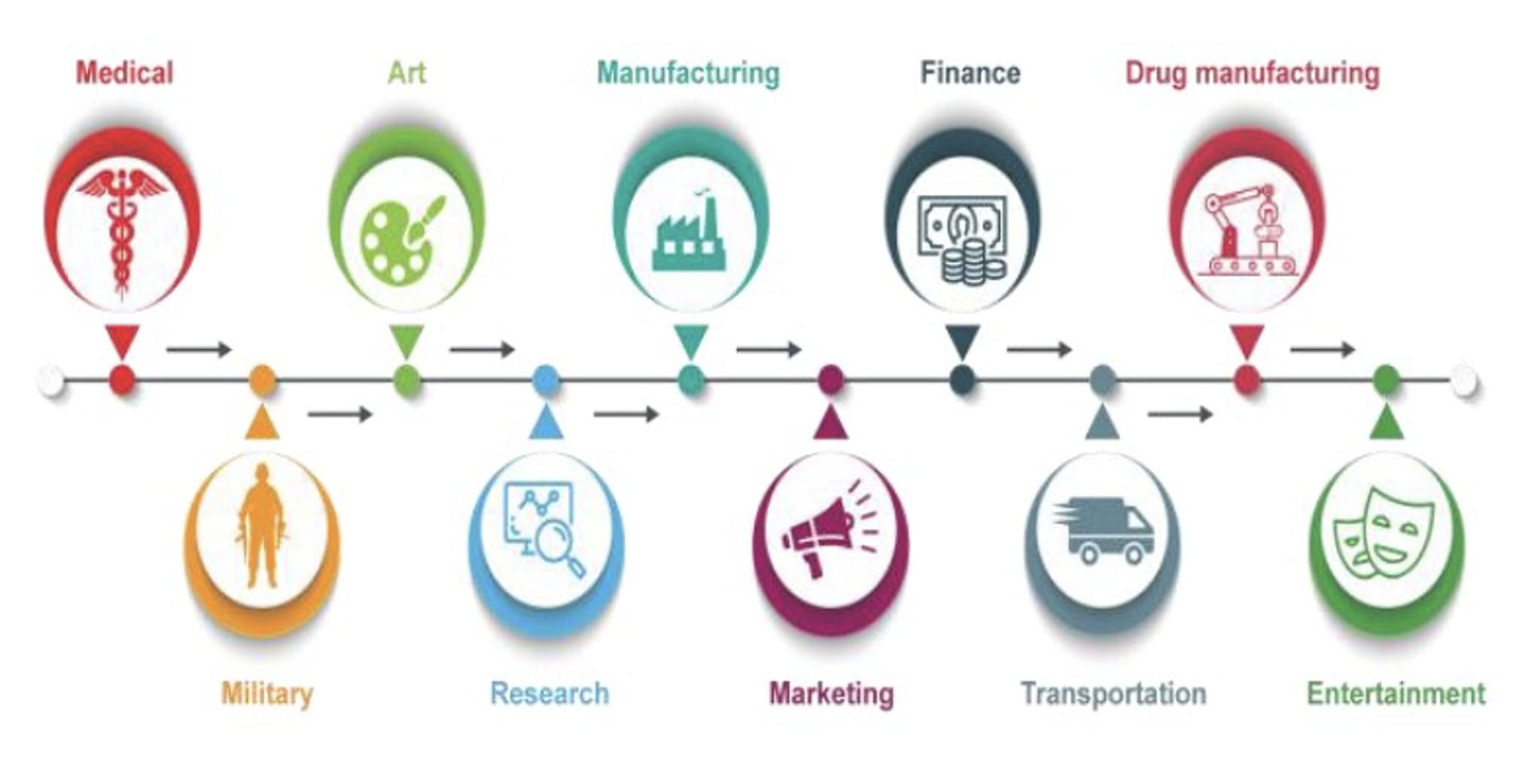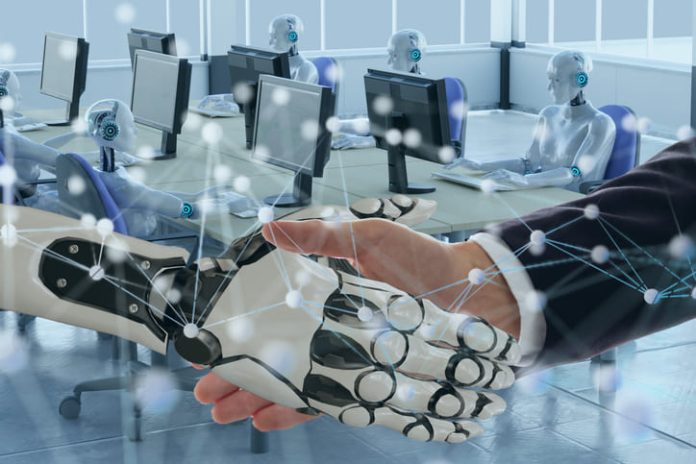By Melika Mohammadzadeh, Supervised by Dr. Anna Rostomyan
The integration of artificial intelligence (AI) into workplaces is rapidly changing the nature of work, particularly in fields like human resources (HR) and customer service. As AI-driven tools become more prevalent, a new set of skills are needed for effective human-machine collaboration. This article examines the critical role of emotional intelligence (EI) in navigating this evolving landscape. Specifically, it addresses how EI influences employee collaboration with AI tools in HR and customer service and its significance in fostering trust and engagement in human-AI workplace interactions. The article concludes by emphasizing the need for organizations to prioritize EI development to ensure a smooth transition into an AI-driven future.
Introduction
The rapid advancement of artificial intelligence (AI) is transforming workplaces across industries. As AI-driven tools become increasingly integrated into HR and customer service, the nature of work is evolving, requiring a new set of skills for effective human-machine collaboration. Emotional intelligence (EI) has emerged as a critical factor in navigating this changing landscape. This report examines the impact of EI on human-AI collaboration, addressing two research questions:
- How does emotional intelligence in employees influence their collaboration with AI-driven tools in HR and customer service?
- What role does EI play in building trust and engagement in human-AI workplace interactions?
Literature review
Theoretical Foundations of Emotional Intelligence in HCI
Understanding the basic tenets of emotion and EI is essential to exploring how these factors influence human-machine collaboration. Martínez-Miranda and Aldea (2004) define emotions as encompassing physiological, behavioral, cognitive, and affective components, all of which shape user experience with AI systems. This complexity highlights the importance of emotion-oriented design in human-computer interaction (HCI), where users’ emotional responses must be factored into interface design. Building on this, appraisal theory, as discussed by Silvennoinen and Jokinen (2020), emphasizes that emotions arise from cognitive appraisals of situations, influencing users’ interactions with AI-driven systems. This suggests that AI tools must align with users’ emotional expectations to foster positive interactions.
Additionally, the shift from Emotional Quotient (EQ) to Emotional Intelligence (EI) underscores the importance of flexibility and context in emotional skills within modern workplaces (NeuroLaunch, 2023).
Unlike EQ, a static measurement akin to IQ, EI reflects a broader, adaptive skill set that involves managing and responding to emotions in a dynamic, context-sensitive way. This distinction is essential in HCI, where interactions with AI require not just a fixed score of empathy or self-regulation, but a continuous, situational ability to respond thoughtfully. Thus, the term EI better captures the evolving skill set needed to manage emotions in nuanced interactions with AI, where emotional sensitivity and adaptability enhance user experience and collaboration.
The Role of Emotional Intelligence in Human-AI Collaboration
Emotional intelligence (EI) encompasses the ability to recognize, understand, use, and manage emotions in oneself and others. In the context of human-AI collaboration, EI is crucial for:
- Effective Communication: AI-driven tools often require clear communication of needs and interpretation of outputs. Employees with high EI can effectively convey their requirements and understand the information provided by AI systems, enhancing productivity and minimizing errors (Pandey, 2023).
- Building Trust: Trust is essential for successful collaboration. Employees who trust the AI tools they work with are more likely to use them effectively and embrace their recommendations. EI allows employees to understand AI’s limitations and interpret its outputs with appropriate caution, fostering trust in the system (Martínez-Miranda & Aldea, 2004).
- Managing Emotions: Working with AI can evoke a range of emotions, from excitement to anxiety. Employees with high EI can regulate their emotions and respond constructively to the challenges of human-AI collaboration.
- Empathy and Understanding: As AI tools become more sophisticated, they can increasingly understand and respond to human emotions. Employees with high EI can contribute to developing these systems, ensuring they interact with users in an empathetic and ethical manner (Peter & Urban, 2011).
Emotional Intelligence and Human-Machine Trust
For effective human-machine collaboration, trust is essential. Chaudhary, Nandan, Arya, and Binjola (2023) argue that EI skills, such as empathy and self-regulation, enable employees to interact with AI tools more openly, leading to greater trust. EI helps users manage expectations, understanding both AI limitations and capabilities, which fosters a realistic sense of reliance on AI-driven outputs. Similarly, Peter and Urban (2011) underscore the importance of integrating empathy into AI systems to make them more responsive to human emotional cues, thereby improving trust and overall engagement. Trust, as described by Gherson (2018), relies not only on AI’s ability to interpret and respond to human emotions but also on users’ constructive engagement with these systems.
AI in HR and Customer Service
AI is rapidly transforming many industries according to Shukla, A., & Agnihotri, A. (2022), (Figure 1). More specifically in this paper we look at AI transforming HR and customer service, automating tasks and providing new insights into human behavior. In HR, AI tools are used for:
- Recruitment and Talent Acquisition: AI tools can screen resumes and identify potential candidates based on predefined criteria. High-EI employees can interpret these AI-driven suggestions with empathy, ensuring the AI’s recommendations align with company values and candidate potential.
- Personalized Learning and Development: AI-driven systems can offer personalized recommendations, helping employees learn and grow. Employees with high EI can leverage these insights to maximize development opportunities.
- Compensation Planning and Performance Management: By recognizing patterns and biases in AI data, high-EI employees contribute to fairer, more transparent HR practices (Pandey, 2023).
In customer service, AI is used for:
4. Chatbots and Virtual Assistants: Offering 24/7 support and quick responses, chatbots are common in customer service. Employees with high EI collaborate effectively with these systems, improving customer experiences and satisfaction.
5. Predictive Analytics: Anticipating customer needs through data-driven insights is another key role of AI. High-EI employees utilize this data to make personalized recommendations and address customer concerns empathetically (Chaudhary et al., 2023).
Shukla and Agnihotri (2022) further argue that EI supports adaptability in customer service, where emotionally intelligent employees help AI tools like chatbots provide personalized responses to customer needs. This balance between automation efficiency and personalized service is particularly relevant in emotionally charged customer service contexts.
Building Trust and Engagement in Human-AI Workplace Interactions
Trust and engagement are crucial for successful human-AI collaboration. Employees who trust AI tools are more likely to use them effectively and be engaged in their work. EI plays a vital role in building trust by:
- Promoting Transparency: Employees with high EI effectively communicate AI’s limitations and decision-making processes, fostering understanding and trust (Silvennoinen & Jokinen, 2020).
- Fostering Empathy: EI allows employees to consider how AI might impact others, leading to more responsible use of these tools (Gherson, 2018).
- Addressing Concerns: Employees with high EI can address concerns about AI objectively and compassionately, building trust and mitigating fears of job displacement.
Ethical Considerations and Emotional AI
As AI systems become more prevalent, there are ethical concerns regarding their influence on emotions in workplace interactions. Silvennoinen and Jokinen (2020) highlight that emotionally intelligent AI requires ethical guidelines to avoid manipulative practices. This aligns with Gherson’s (2018) assertion that AI-driven tools must operate transparently to retain user trust and engagement, especially when handling personal or emotionally sensitive information.
Conclusion
As AI continues to transform the workplace, EI is increasingly critical to successful human-machine collaboration. Humans being emotional beings will result in the importance of having emotional AI as well as emotionally intelligent workers to cultivate a better human computer collaboration at workplaces.
Employees with high EI will be better equipped to:
- Communicate effectively with AI systems.
- Build trust and engagement in human-AI interactions.
- Leverage AI insights for better decision-making and performance.
- Ensure ethical and responsible use of AI tools.
Organizations should prioritize developing EI skills in their workforce through training, coaching, and a supportive culture that values EI. By embracing EI, organizations can unlock the full potential of human-AI collaboration, creating a more productive, engaging, and fulfilling workplace.
Discussion
The findings of this report suggest that while AI has introduced efficiency and precision into many workplace functions, it also brings challenges that require high levels of emotional intelligence to navigate effectively. As AI-driven tools are deployed across HR and customer service roles, they frequently handle sensitive, human-centered tasks such as candidate selection, performance management, and customer interactions. Integrating EI in these areas addresses several core issues:
1. Trust and Engagement in AI-Driven Processes
The relationship between trust, EI, and human-AI collaboration is complex. Trust is not only an essential component for successful collaboration but also a potential barrier when lacking. As noted by Martínez-Miranda and Aldea (2004), emotions play a significant role in shaping user perceptions of AI systems. Employees with higher EI levels are better positioned to foster trust by accurately interpreting AI outputs and recognizing AI’s limitations, which encourages more responsible and effective use. This foundation of trust is critical, as without it, employees are less likely to engage meaningfully with AI tools, and the benefits of these technologies may not be fully realized.
2. Enhanced Decision-Making and Empathy in HR and Customer Service
In HR and customer service, AI’s capacity to analyze data quickly and objectively can sometimes conflict with the need for empathetic judgment. Emotionally intelligent employees can mediate this tension by interpreting AI-driven insights through an empathetic lens, ensuring that decisions align with organizational values and human needs. For example, during candidate recruitment, high-EI employees can use AI’s insights on candidate fit while also weighing interpersonal skills or cultural fit—factors that AI may not fully capture. Similarly, in customer service, EI enables employees to support AI-driven chatbots in ways that prioritize empathy, enhancing overall customer satisfaction (Chaudhary et al., 2023; Shukla & Agnihotri, 2022).
3. Ethical Implications of Emotionally Responsive AI
As AI tools evolve, they are increasingly designed to respond to human emotions, raising ethical considerations. Silvennoinen and Jokinen (2020) argue that for AI to remain trustworthy, it must operate transparently, particularly when interpreting or responding to emotional cues. Emotionally intelligent employees are more adept at recognizing when AI behavior may unintentionally infringe on ethical boundaries, such as privacy concerns in data handling or manipulative emotional responses. EI skills enable employees to use AI ethically, promoting transparency and respecting users’ emotional boundaries. Ensuring ethical guidelines in emotionally responsive AI is critical as these systems become more capable of influencing users’ emotions.
Figure 1: Various Industries utilizing AI (Shukla, A., & Agnihotri, 2022)

References
- Averill, J. R. (1980). A constructivist view of emotion. In R. Plutchik & H. Kellerman (Eds.), Emotion: Theory, research, and experience: Vol. 1. Theories of emotion (pp. 305–339). Academic Press.
- Bower, G. H. (1992). How might emotions affect learning? The Handbook of Emotion and Memory: Research and Theory, 3-31.
- Chaudhary, T., Nandan, A., Arya, M., & Binjola, R. (2023). Connect between artificial intelligence and emotional intelligence at workplace. ResearchGate.
https://doi.org/10.13140/RG.2.2.11440.28169 - Darwin, C. (1872/1998). The expression of the emotions in man and animals. Oxford UniversityPress.
- Gherson, D. (2018). The business case for AI in HR: With insights and tips on getting started.
- IBM Watson Talent.
- Magapu, S. S., & Vaddiparty, S. (2019). The study of emotional intelligence in artificial intelligence. International Journal of Innovative Science and Research Technology, 4(1), 594–602.
- Martínez-Miranda, J., & Aldea, A. (2004). Emotions in human and artificial intelligence.
Computers in Human Behavior, 21(2005), 323–341. https://doi.org/10.1016/j.chb.2004.02.010
- Pandey, P. (2023). Emotional intelligence skills in the age of AI: A review. International Journal for Multidisciplinary Research (IJFMR).
- Peter, C., & Urban, B. (2011). Emotion in human-computer interaction. In P. Petta, C. Pelachaud, & R. Cowie (Eds.), Emotion-oriented systems: The humaine handbook (pp. 27-39). SpringerInternational Publishing.
- Shukla, A., & Agnihotri, A. (2022). Emotional intelligence is now more necessary than ever due to the use of artificial intelligence in the workplace. International Journal of All Research Education and Scientific Methods (IJARESM), 10(9).
- Silvennoinen, J., & Jokinen, J. P. P. (2020). The appraisal theory of emotion in human–computer interaction. In R. Rousi, J. Leikas, & P. Saariluoma (Eds.), Emotions in Technology Design: From Experience to Ethics (pp. 27–39). Springer International Publishing.
https://doi.org/10.1007/978-3-030-53483-7_3 - (2023, October 5). Emotional intelligence vs. emotional quotient: Key differences and why they matter. NeuroLaunch.
https://neurolaunch.com/emotional-intelligence-vs-emotional-quotient/





































